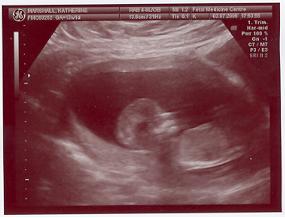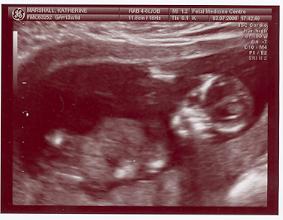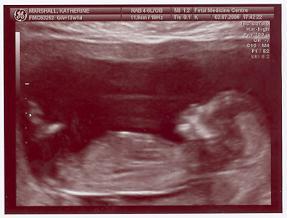Finally, we were called into the scan room. In my previous post I noted that just because you go private, it doesn't mean you don't have to wait. I should also mention that the scanning room was much better than the one at our local hospital; bigger, brighter... The actual procedure was much the same as before; pull the skirt down and get a load of clear jelly squirted onto the mother's belly and away you go. However, as soon as the pictures appeared on screen, they were just a whole level of magnitude clearer.
The first thing we noticed was that the baby was the other way up. This meant that we could get a better impression of the features. It's quite remarkable how clear they are, given that just K___'s breathing is constantly moving where the ultrasound wand is focussed. Even though what you're seeing on the screen is just a few centimetres in length, everything about it is a recognisable baby. S/he won't change that much between now and birth with the exception of size.
I'm not going to get bogged down in a long discussion here because it's extremely emotive at the best of times, but I do have a better understanding of how pro-lifers can make their claims that foetuses are human beings even at this stage of development. We both support the right of women to have abortions, and don't believe that foetuses at this stage of development have the same rights as a mother because they are not viable. Nevertheless, it's also true that we would be totally gutted if anything were to happen to our baby at this stage (the fact that I call it a baby is undoubtedly revealing), and I don't think there'd be much difference if this were to happen now or in 11 weeks time. To my mind, this reveals the dangers of allowing people who are emotionally involved to have a say in such discussions, but I'm sure there are others who would argue equally vociferously that an argument without an emotional component is a bad one. There is currently a call from 60 MPs to Parliament to debate whether changes need to be made to the 1967 law that allows abortion up to 24 weeks, because medical advance now make it more likely a foetus is potentially viable earlier and it's clear that this is a serious moral and ethical quagmire. I wouldn't say this experience has changed my mind, but it's certainly given me a better understanding of where the contrary position comes from; one from experience.
The box of tricks that our scanning technician was using seemed to be very much more advanced than the one we'd seen at the local hospital. She was also flying solo and seemed to be able to change all sorts of parameters with just the one hand (the other holding the device to K___'s stomach). One of the first things we do was listen to the baby's heart. I've recently heard a baby's heart beat, courtesy of jonandnic.com (see the links) so it wasn't too surprising to me, but it was nevertheless incredible to hear this tiny engine thumping along at 150 BPM. I asked whether they could save the wav file to something for us to have, but apparently they aren't set up to do that. Probably it's never occurred to them. It wouldn't have done to me either except for Jon and Nic's one. It doesn't matter; it was still very cool.
Another trick they did was to turn on some sort of colour coding that revealed where the blood vessels are. Blood that is travelling towards the ultrasound machine appears as red, away as blue - this shouldn't be mistaken for arteries and veins though - I asked. By positioning the mouse pointer over some of these coloured spots, the ultrasound can isolate the sound of the individual vessels. They sound very mad. No, actually, what they really sound like is some of my phaser and flanger guitar pedals! Perhaps baby is a shoegazer..?!
With a bit of jiggling of the probe, the technician finally got her in a position where the baby's head was in profile. She immediately zoomed in on the features and pointed out a prominent white line where the baby's nose bone was. A very good sign and I squeezed K___'s hand. It took quite a while to get a look at the back of the neck where the nuchal fold is located but finally she was able to do it. The technician murmured some number - one point something - but I didn't quite catch it and in any case didn't know if that was good or bad. I thought she wanted anther try but wasn't able to get a good reading but after taking a few more bits and bobs from the baby's heart and major blood vessels, she put the probe down, got K___ to clean her stomach of the gel and turned to her computer monitor and got it to compute the chances of Down's.
Well, let's cut to the chase. A woman of K___'s age at 13 weeks pregnant has a 1 in 500-ish chance of having a Down's baby, falling to 1 in 900 at birth. With every other factor added in, our technician was able to give us the odds of 1 in 10,500 chance. It could still happen, but it's difficult to look at those odds at any other way than with great relief and happiness.
I don't know. Maybe it was better when we didn't know all these things and you just got to 9 months and had a baby. Maybe having all the knowledge about what might happen just gets us stressed and doesn't do us any good. But on the other hand, our data will be added to the pool. When our child is born, we'll add additional bit of info to the Fetal Medical School's data and it will go a tiny way towards increasing our understanding of what's happening and maybe that will help those women who are unlucky enough to draw the short straw?
Sorry if that sounded like an Orko moment! Here's the pictures:



The argument with women and age, as I understand it, goes that because all of their eggs are present at birth, as they get older the eggs are older and therefore more likely to contain genetic errors.
ReplyDeleteBut I've seen studies where they've made the point that because sperm contains a copy of the DNA at the point it is created, that too must therefore be affected by age. The analogy I've seen was take a photocopy of a book. Then photocopy the resulting photocopy. Then photocopy that photocopy and so on. By the time you're a few generations down the line there's clear differences in the quality of the information being passed on.
That makes total sense to me, so it seems obvious that the age of both parents is likely to have an effect.